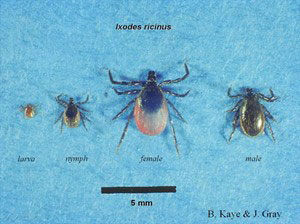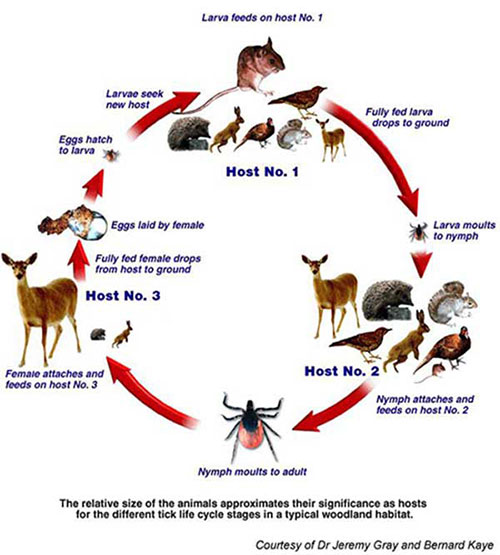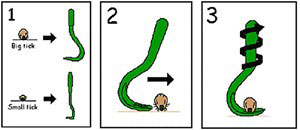Ticks are small parasites that survive by feeding on different animal hosts, including mammals, birds and even humans if they get the opportunity. They can be a real nuisance for affected pets, often causing irritation, inflammation and sometimes infection and disease.
There are many tick species in the UK but the ones that commonly cause problems by feeding off our pets, are the sheep tick (Ixodes ricinus) and the hedgehog tick (Ixodes hexagonus).
Ticks are mostly found in areas with long grasses, in woodlands or in heathland but they can be found in gardens if they have been transported by wild animals during their larval or nymph stages. They can attach anywhere on the animal’s body but are usually found around the head, neck and ears. Owners often mistake ticks for wart-like growths on their pets because of their size and colour.

Tick facts
- Ticks transfer saliva into their host and remove blood as they feed
- The tick body swells up as it becomes engorged with blood
- Ticks are usually active in the spring, summer and autumn months
- Larval ticks have 6 legs and are so small they look like specks of dirt
- Nymph ticks have 8 legs and are about the size of a poppy seed, and are the most likely stage to bite humans
- Adult ticks also have 8 legs. The female is much larger than the male and grows to about pea-size when fully engorged with blood
- Ticks will happily feed off humans if there are no other convenient food sources available
- Never be tempted just to brush or pull off the tick – any mouth parts left in your pet’s skin may become infected, resulting in an abscess
- Ticks can transmit many diseases through their saliva including Lyme Disease and Babesiosis in the UK and Erlichiosis in other countries
- Ticks can carry several different infections at the same time
- Localised infection may occur at the site of attachment without causing other symptoms in the animal’s body
- If an animal has a really heavy tick infestation it could become anaemic

Tick Transmitted Canine and Feline Borreliosis (Lyme Disease) in the UK
Cats are rarely affected with this disease (or it is not commonly diagnosed and reported as clinical symptoms can be the same as many other disease processes). Dogs can be infected with this disease and show no clinical symptoms at all (Subclinical) however, when infection does develop it may persist for several years. The most commonly seen symptoms are
- Lethargy
- Anorexia
- High Temperature
- Inflammatory arthritis (involving one or multiple joints)
- Swollen lymph nodes
- In rare cases the disease can affect the kidneys, heart and nervous system
Tick Transmitted Canine Babesiosis in the UK
Babesiosis a dog illness caused by Babesia Canis or Babesia gibsoni, that is transmitted by ticks; it infects red blood cells and can cause severe anaemia and immune-mediated haemolytic anaemia.
Babesia is usually only found in the warmer climates of North America, continental Europe, Africa and Asia, but recently it has been affecting some dogs in parts of the Uk, where it is thought that the parasite carrying tick (or ticks) may have entered the UK on an animal using the Pet Passport Scheme (since the requirements were relaxed, animals no longer need to have treatment for ticks applied before they return to the UK!) or via one of the many illegally imported puppies that enter the UK for sale and have had no treatments at all.
Common Tick Life Cycle
- Larval ticks hatch from the eggs and the following spring or autumn they crawl onto grass stems and seek out small rodent hosts using the sensory organs on their front legs. The larvae feed for several days before dropping off into the environment to moult into nymphs (In the UK this stage usually takes a year to complete)
- Nymph ticks seek out slightly larger hosts this time – usually rabbits, and feed for several days before dropping off into the environment to moult into adult ticks (Again, taking about a year)
- Adult ticks climb up onto taller vegetation to seek out a host. They usually feed off larger animals such as sheep, deer, dogs and cats. The adult female feeds for up to two weeks and then drops off into the environment and can lay several thousand eggs before dying
- The whole life cycle can take up to 3 years to complete in the UK

Common Ticks found on dogs and cats in the UK
Ixodes Ricinus
- Also known as the sheep tick, castor bean tick or deer tick. Despite its name it will feed on any mammals or birds and lizards
- Its preferred hosts for the larval and nymph stages are small animals (rodents then rabbits and birds) and for the adults, large animals such as sheep and deer on which it has the greatest reproductive success
- It is the most common tick to be found feeding on dogs and humans in it’s nymph and adult stages. This is likely due to the fact that it searches for a host by climbing up to the top of tall vegetation, so passing pets are easy targets
- It only feeds once at each developmental stage
Ixodes Hexagonus
- Known as the hedgehog tick
- It is often the most common tick found on cats and the second most common tick on dogs
- The larvae are mainly found on hedgehogs (hence the name) and also other smallish mammals that have nests/dens such as stoats, weasels, foxes and badgers
- Pets are accidental hosts because hedgehogs commonly live in parks and gardens
How to remove a tick from your pet
We recommend that this is done using a specially designed ‘tick hook’ (pictured), these are readily available from veterinary practices, pet shops and on-line. If you are unsure how to use one, bring your pet to the practice and one of our nurses can show you how it’s done.

- Make sure your pet is nice and calm. You will be unable to remove the tick properly from a wiggly, bouncy pet, so use some tasty treats and praise to help keep them still
- Expose the tick by parting your pet’s hair so you can see it clearly
- Slide the tick hook under the tick as close to your pet’s skin as you can ge
- Gently twist the tick hook around (left or right doesn’t matter!) with a very gentle upward motion and the tick should come free – if the tick is wiggling you have successfully removed the whole thing (yuck!)
- Kill the tick to ensure it won’t just jump back onto your pet (or you!) if you are squeamish, you can put it into a sealable container and then into the bin
- Bathe the area where the tick was attached in a saltwater solution (1 – 2 teaspoons salt in 500ml of boiled water that has been cooled) or pet antiseptic wash/wipes
- Reward your pet for sitting still
- It is a good idea to make a note of the date that the tick was removed, in case of later infection so that your vet has a timeline
- Speak to your veterinary practice about tick prevention methods
How NOT to remove Ticks
If any part of the tick is left in your pet’s skin it may cause infection, abscess or the transmission of disease. In order to avoid this
- DO NOT pull the tick off your pet, using fingers or tweezers
- DO NOT burn the tick off your pet; you could seriously injure your pet.
- DO NOT use alcohol on the tick; It won’t make the tick drop off and we feel that alcohol has better uses!
- DO NOT use Vaseline; whilst it will eventually smother the tick, it will take 24-48 hours to work
- DO NOT use nail varnish to smother the tick – this is likely to irritate your pet’s skin
If you have tried to remove a tick, but think that some of it is still under your pet’s skin, please contact your veterinary practice for advice.
Tick Prevention
Fortunately there are now several really great products that repel ticks (and fleas) available for your dog and cat. These products are only available from your veterinary practice or can be obtained from a pharmacy if you have a prescription from your vet.
Castle Vets recommend tick products that actually repel the ticks and prevent them from attaching to your pet for a meal. It is really important that you check any products and read the labelling carefully before you buy them. Most products that state they are for treating ticks, only kill the tick AFTER it has attached to your pet and drank blood.
WARNING – Never use dog flea or tick products on cats. The active ingredient used in some dog products is highly toxic to cats and can cause seizures and death
Further Information
Please contact us at the practice if you would like advice on parasite prevention and treatments or to make an appointment with one of our veterinary nurses who can show you how to remove ticks safely. You can telephone us on 0118 957 4488.